Financial Analysis of UberTools Ltd: Business Finance Report
VerifiedAdded on 2020/10/22
|11
|3612
|479
Report
AI Summary
This report delves into the realm of business finance, focusing on the core concepts of cash flow, profit, and working capital management within the context of UberTools Ltd. Part A meticulously defines profit and cash flow, highlighting their differences, and explores the significance of working capital components such as receivables, inventory, and payables. It examines how changes in working capital directly impact cash flow, providing an application of these concepts to UberTools Ltd's financial situation. Part B then shifts the focus to financial performance, outlining key elements like assets, liabilities, and equity, while also including the calculation and analysis of relevant financial ratios. The report culminates in a comprehensive analysis and recommendations for enhancing UberTools Ltd's cash flow through improved working capital management, incorporating practical steps such as improving stock management, leasing instead of buying, implementing electronic payments, negotiating with suppliers, and utilizing up-to-date financial information.
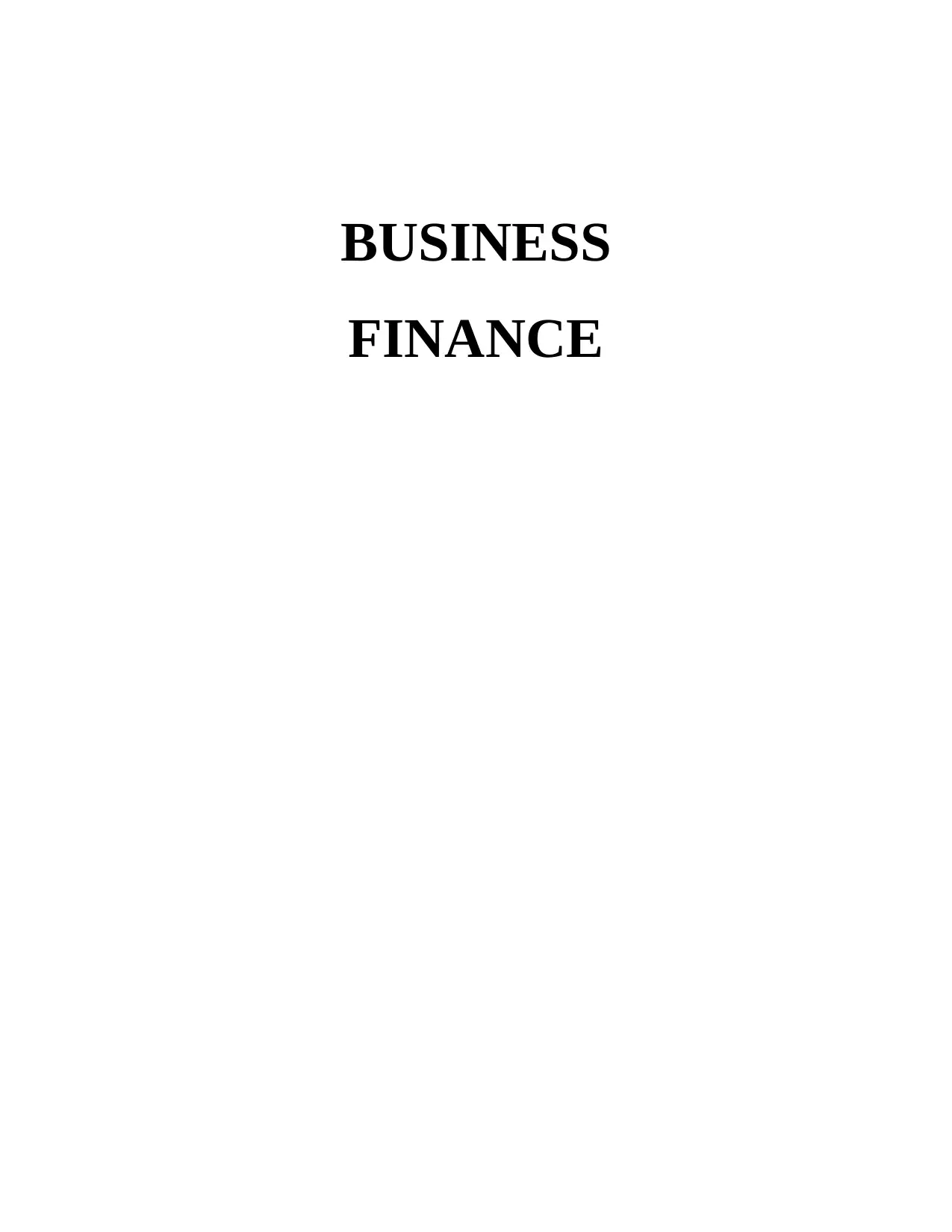
BUSINESS
FINANCE
FINANCE
Paraphrase This Document
Need a fresh take? Get an instant paraphrase of this document with our AI Paraphraser
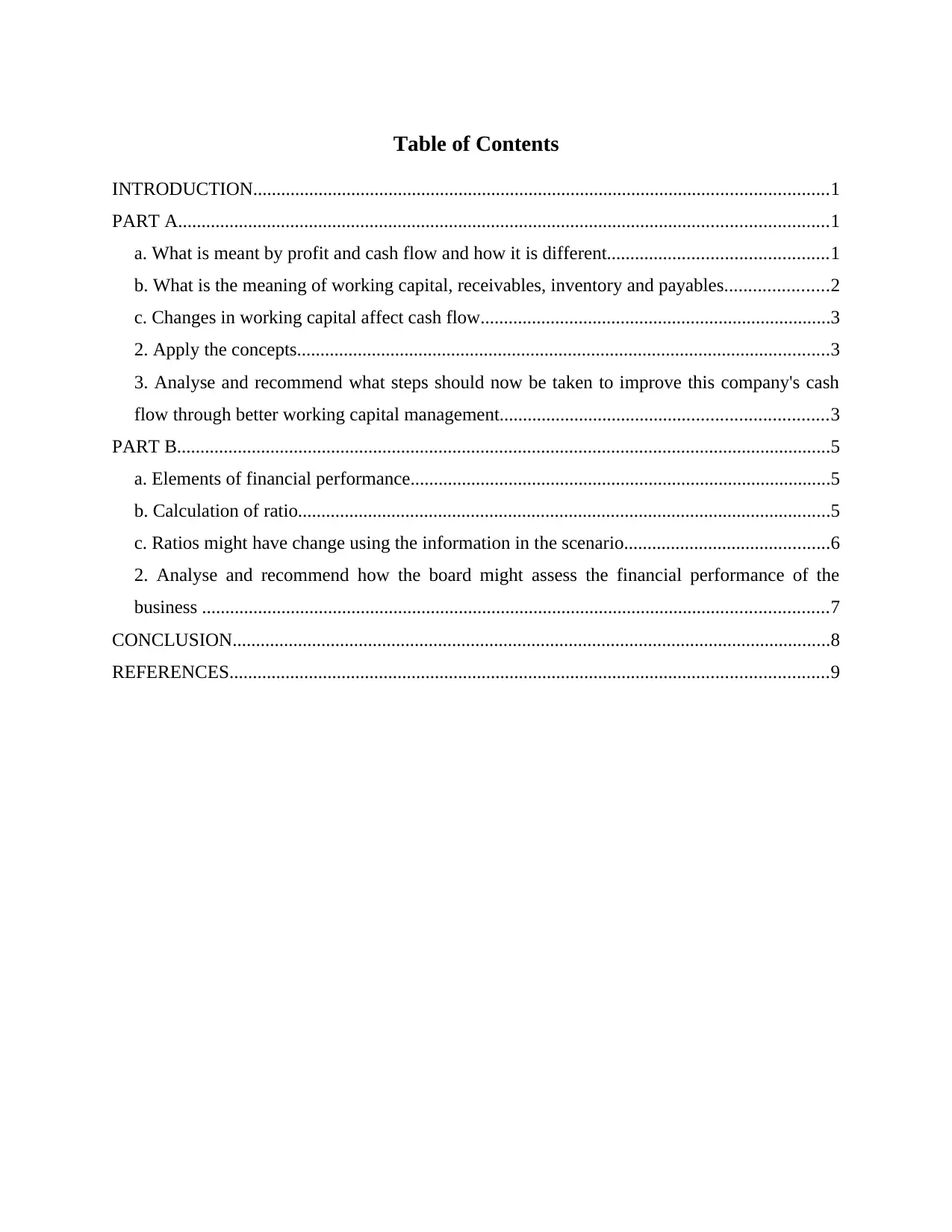
Table of Contents
INTRODUCTION...........................................................................................................................1
PART A...........................................................................................................................................1
a. What is meant by profit and cash flow and how it is different...............................................1
b. What is the meaning of working capital, receivables, inventory and payables......................2
c. Changes in working capital affect cash flow...........................................................................3
2. Apply the concepts..................................................................................................................3
3. Analyse and recommend what steps should now be taken to improve this company's cash
flow through better working capital management......................................................................3
PART B............................................................................................................................................5
a. Elements of financial performance..........................................................................................5
b. Calculation of ratio..................................................................................................................5
c. Ratios might have change using the information in the scenario............................................6
2. Analyse and recommend how the board might assess the financial performance of the
business ......................................................................................................................................7
CONCLUSION................................................................................................................................8
REFERENCES................................................................................................................................9
INTRODUCTION...........................................................................................................................1
PART A...........................................................................................................................................1
a. What is meant by profit and cash flow and how it is different...............................................1
b. What is the meaning of working capital, receivables, inventory and payables......................2
c. Changes in working capital affect cash flow...........................................................................3
2. Apply the concepts..................................................................................................................3
3. Analyse and recommend what steps should now be taken to improve this company's cash
flow through better working capital management......................................................................3
PART B............................................................................................................................................5
a. Elements of financial performance..........................................................................................5
b. Calculation of ratio..................................................................................................................5
c. Ratios might have change using the information in the scenario............................................6
2. Analyse and recommend how the board might assess the financial performance of the
business ......................................................................................................................................7
CONCLUSION................................................................................................................................8
REFERENCES................................................................................................................................9
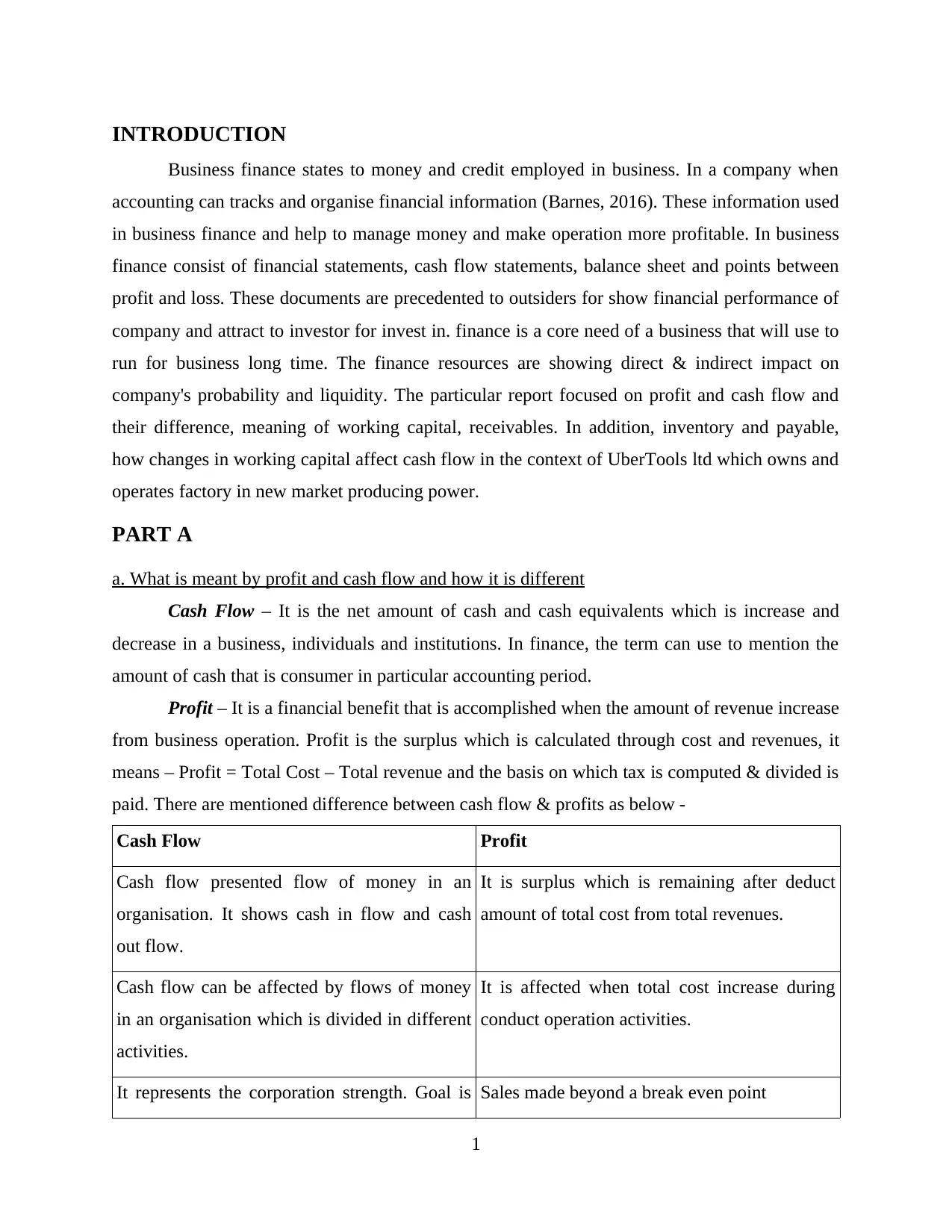
INTRODUCTION
Business finance states to money and credit employed in business. In a company when
accounting can tracks and organise financial information (Barnes, 2016). These information used
in business finance and help to manage money and make operation more profitable. In business
finance consist of financial statements, cash flow statements, balance sheet and points between
profit and loss. These documents are precedented to outsiders for show financial performance of
company and attract to investor for invest in. finance is a core need of a business that will use to
run for business long time. The finance resources are showing direct & indirect impact on
company's probability and liquidity. The particular report focused on profit and cash flow and
their difference, meaning of working capital, receivables. In addition, inventory and payable,
how changes in working capital affect cash flow in the context of UberTools ltd which owns and
operates factory in new market producing power.
PART A
a. What is meant by profit and cash flow and how it is different
Cash Flow – It is the net amount of cash and cash equivalents which is increase and
decrease in a business, individuals and institutions. In finance, the term can use to mention the
amount of cash that is consumer in particular accounting period.
Profit – It is a financial benefit that is accomplished when the amount of revenue increase
from business operation. Profit is the surplus which is calculated through cost and revenues, it
means – Profit = Total Cost – Total revenue and the basis on which tax is computed & divided is
paid. There are mentioned difference between cash flow & profits as below -
Cash Flow Profit
Cash flow presented flow of money in an
organisation. It shows cash in flow and cash
out flow.
It is surplus which is remaining after deduct
amount of total cost from total revenues.
Cash flow can be affected by flows of money
in an organisation which is divided in different
activities.
It is affected when total cost increase during
conduct operation activities.
It represents the corporation strength. Goal is Sales made beyond a break even point
1
Business finance states to money and credit employed in business. In a company when
accounting can tracks and organise financial information (Barnes, 2016). These information used
in business finance and help to manage money and make operation more profitable. In business
finance consist of financial statements, cash flow statements, balance sheet and points between
profit and loss. These documents are precedented to outsiders for show financial performance of
company and attract to investor for invest in. finance is a core need of a business that will use to
run for business long time. The finance resources are showing direct & indirect impact on
company's probability and liquidity. The particular report focused on profit and cash flow and
their difference, meaning of working capital, receivables. In addition, inventory and payable,
how changes in working capital affect cash flow in the context of UberTools ltd which owns and
operates factory in new market producing power.
PART A
a. What is meant by profit and cash flow and how it is different
Cash Flow – It is the net amount of cash and cash equivalents which is increase and
decrease in a business, individuals and institutions. In finance, the term can use to mention the
amount of cash that is consumer in particular accounting period.
Profit – It is a financial benefit that is accomplished when the amount of revenue increase
from business operation. Profit is the surplus which is calculated through cost and revenues, it
means – Profit = Total Cost – Total revenue and the basis on which tax is computed & divided is
paid. There are mentioned difference between cash flow & profits as below -
Cash Flow Profit
Cash flow presented flow of money in an
organisation. It shows cash in flow and cash
out flow.
It is surplus which is remaining after deduct
amount of total cost from total revenues.
Cash flow can be affected by flows of money
in an organisation which is divided in different
activities.
It is affected when total cost increase during
conduct operation activities.
It represents the corporation strength. Goal is Sales made beyond a break even point
1
⊘ This is a preview!⊘
Do you want full access?
Subscribe today to unlock all pages.

Trusted by 1+ million students worldwide
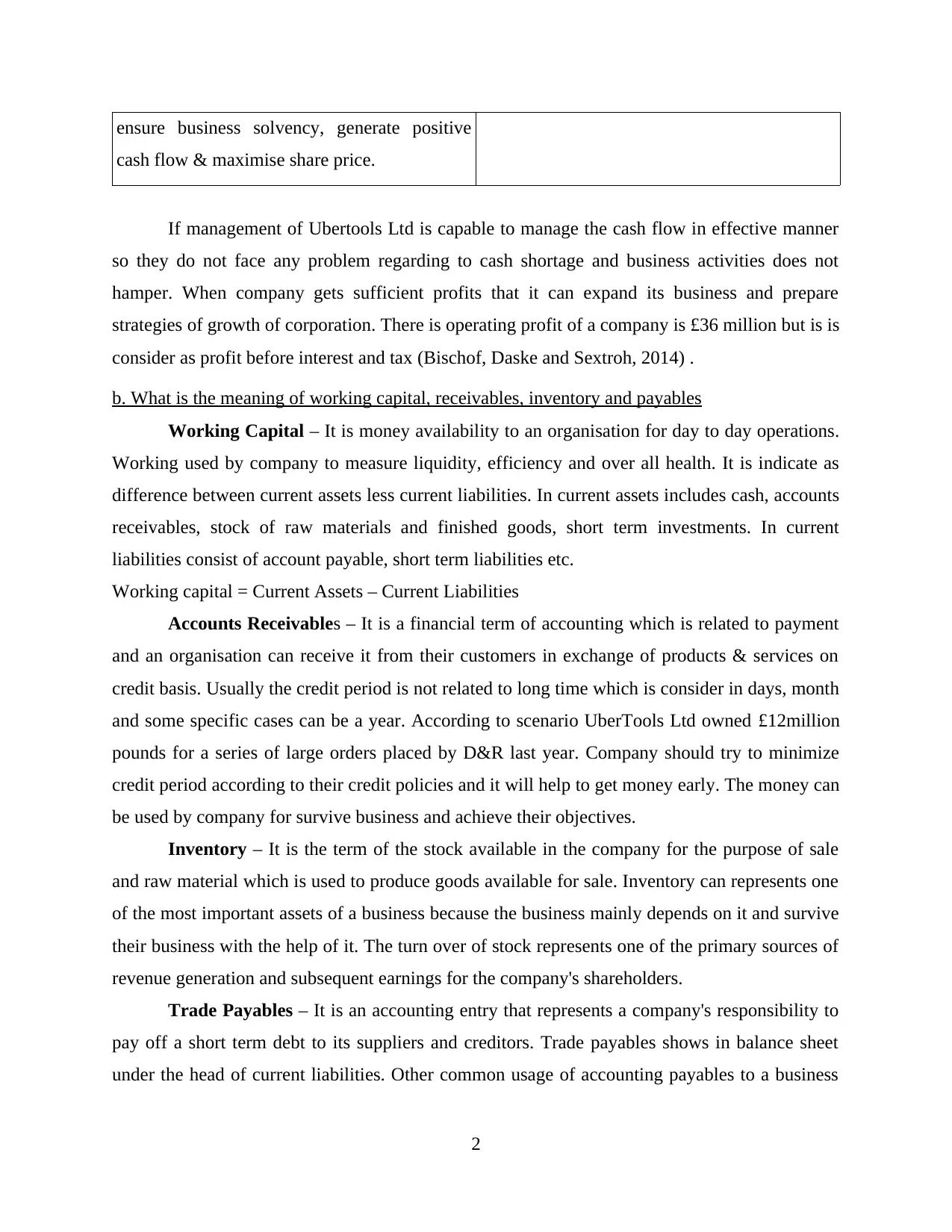
ensure business solvency, generate positive
cash flow & maximise share price.
If management of Ubertools Ltd is capable to manage the cash flow in effective manner
so they do not face any problem regarding to cash shortage and business activities does not
hamper. When company gets sufficient profits that it can expand its business and prepare
strategies of growth of corporation. There is operating profit of a company is £36 million but is is
consider as profit before interest and tax (Bischof, Daske and Sextroh, 2014) .
b. What is the meaning of working capital, receivables, inventory and payables
Working Capital – It is money availability to an organisation for day to day operations.
Working used by company to measure liquidity, efficiency and over all health. It is indicate as
difference between current assets less current liabilities. In current assets includes cash, accounts
receivables, stock of raw materials and finished goods, short term investments. In current
liabilities consist of account payable, short term liabilities etc.
Working capital = Current Assets – Current Liabilities
Accounts Receivables – It is a financial term of accounting which is related to payment
and an organisation can receive it from their customers in exchange of products & services on
credit basis. Usually the credit period is not related to long time which is consider in days, month
and some specific cases can be a year. According to scenario UberTools Ltd owned £12million
pounds for a series of large orders placed by D&R last year. Company should try to minimize
credit period according to their credit policies and it will help to get money early. The money can
be used by company for survive business and achieve their objectives.
Inventory – It is the term of the stock available in the company for the purpose of sale
and raw material which is used to produce goods available for sale. Inventory can represents one
of the most important assets of a business because the business mainly depends on it and survive
their business with the help of it. The turn over of stock represents one of the primary sources of
revenue generation and subsequent earnings for the company's shareholders.
Trade Payables – It is an accounting entry that represents a company's responsibility to
pay off a short term debt to its suppliers and creditors. Trade payables shows in balance sheet
under the head of current liabilities. Other common usage of accounting payables to a business
2
cash flow & maximise share price.
If management of Ubertools Ltd is capable to manage the cash flow in effective manner
so they do not face any problem regarding to cash shortage and business activities does not
hamper. When company gets sufficient profits that it can expand its business and prepare
strategies of growth of corporation. There is operating profit of a company is £36 million but is is
consider as profit before interest and tax (Bischof, Daske and Sextroh, 2014) .
b. What is the meaning of working capital, receivables, inventory and payables
Working Capital – It is money availability to an organisation for day to day operations.
Working used by company to measure liquidity, efficiency and over all health. It is indicate as
difference between current assets less current liabilities. In current assets includes cash, accounts
receivables, stock of raw materials and finished goods, short term investments. In current
liabilities consist of account payable, short term liabilities etc.
Working capital = Current Assets – Current Liabilities
Accounts Receivables – It is a financial term of accounting which is related to payment
and an organisation can receive it from their customers in exchange of products & services on
credit basis. Usually the credit period is not related to long time which is consider in days, month
and some specific cases can be a year. According to scenario UberTools Ltd owned £12million
pounds for a series of large orders placed by D&R last year. Company should try to minimize
credit period according to their credit policies and it will help to get money early. The money can
be used by company for survive business and achieve their objectives.
Inventory – It is the term of the stock available in the company for the purpose of sale
and raw material which is used to produce goods available for sale. Inventory can represents one
of the most important assets of a business because the business mainly depends on it and survive
their business with the help of it. The turn over of stock represents one of the primary sources of
revenue generation and subsequent earnings for the company's shareholders.
Trade Payables – It is an accounting entry that represents a company's responsibility to
pay off a short term debt to its suppliers and creditors. Trade payables shows in balance sheet
under the head of current liabilities. Other common usage of accounting payables to a business
2
Paraphrase This Document
Need a fresh take? Get an instant paraphrase of this document with our AI Paraphraser
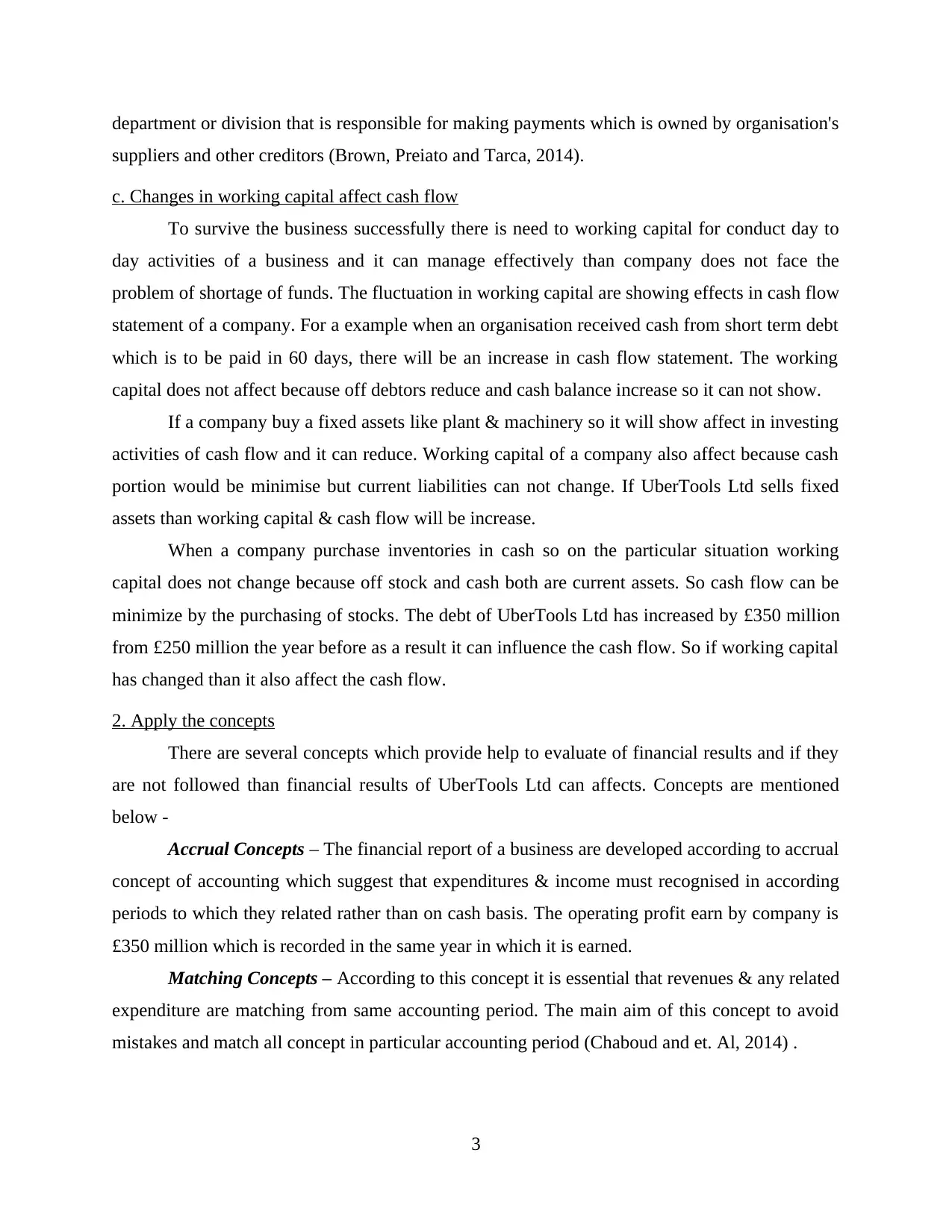
department or division that is responsible for making payments which is owned by organisation's
suppliers and other creditors (Brown, Preiato and Tarca, 2014).
c. Changes in working capital affect cash flow
To survive the business successfully there is need to working capital for conduct day to
day activities of a business and it can manage effectively than company does not face the
problem of shortage of funds. The fluctuation in working capital are showing effects in cash flow
statement of a company. For a example when an organisation received cash from short term debt
which is to be paid in 60 days, there will be an increase in cash flow statement. The working
capital does not affect because off debtors reduce and cash balance increase so it can not show.
If a company buy a fixed assets like plant & machinery so it will show affect in investing
activities of cash flow and it can reduce. Working capital of a company also affect because cash
portion would be minimise but current liabilities can not change. If UberTools Ltd sells fixed
assets than working capital & cash flow will be increase.
When a company purchase inventories in cash so on the particular situation working
capital does not change because off stock and cash both are current assets. So cash flow can be
minimize by the purchasing of stocks. The debt of UberTools Ltd has increased by £350 million
from £250 million the year before as a result it can influence the cash flow. So if working capital
has changed than it also affect the cash flow.
2. Apply the concepts
There are several concepts which provide help to evaluate of financial results and if they
are not followed than financial results of UberTools Ltd can affects. Concepts are mentioned
below -
Accrual Concepts – The financial report of a business are developed according to accrual
concept of accounting which suggest that expenditures & income must recognised in according
periods to which they related rather than on cash basis. The operating profit earn by company is
£350 million which is recorded in the same year in which it is earned.
Matching Concepts – According to this concept it is essential that revenues & any related
expenditure are matching from same accounting period. The main aim of this concept to avoid
mistakes and match all concept in particular accounting period (Chaboud and et. Al, 2014) .
3
suppliers and other creditors (Brown, Preiato and Tarca, 2014).
c. Changes in working capital affect cash flow
To survive the business successfully there is need to working capital for conduct day to
day activities of a business and it can manage effectively than company does not face the
problem of shortage of funds. The fluctuation in working capital are showing effects in cash flow
statement of a company. For a example when an organisation received cash from short term debt
which is to be paid in 60 days, there will be an increase in cash flow statement. The working
capital does not affect because off debtors reduce and cash balance increase so it can not show.
If a company buy a fixed assets like plant & machinery so it will show affect in investing
activities of cash flow and it can reduce. Working capital of a company also affect because cash
portion would be minimise but current liabilities can not change. If UberTools Ltd sells fixed
assets than working capital & cash flow will be increase.
When a company purchase inventories in cash so on the particular situation working
capital does not change because off stock and cash both are current assets. So cash flow can be
minimize by the purchasing of stocks. The debt of UberTools Ltd has increased by £350 million
from £250 million the year before as a result it can influence the cash flow. So if working capital
has changed than it also affect the cash flow.
2. Apply the concepts
There are several concepts which provide help to evaluate of financial results and if they
are not followed than financial results of UberTools Ltd can affects. Concepts are mentioned
below -
Accrual Concepts – The financial report of a business are developed according to accrual
concept of accounting which suggest that expenditures & income must recognised in according
periods to which they related rather than on cash basis. The operating profit earn by company is
£350 million which is recorded in the same year in which it is earned.
Matching Concepts – According to this concept it is essential that revenues & any related
expenditure are matching from same accounting period. The main aim of this concept to avoid
mistakes and match all concept in particular accounting period (Chaboud and et. Al, 2014) .
3
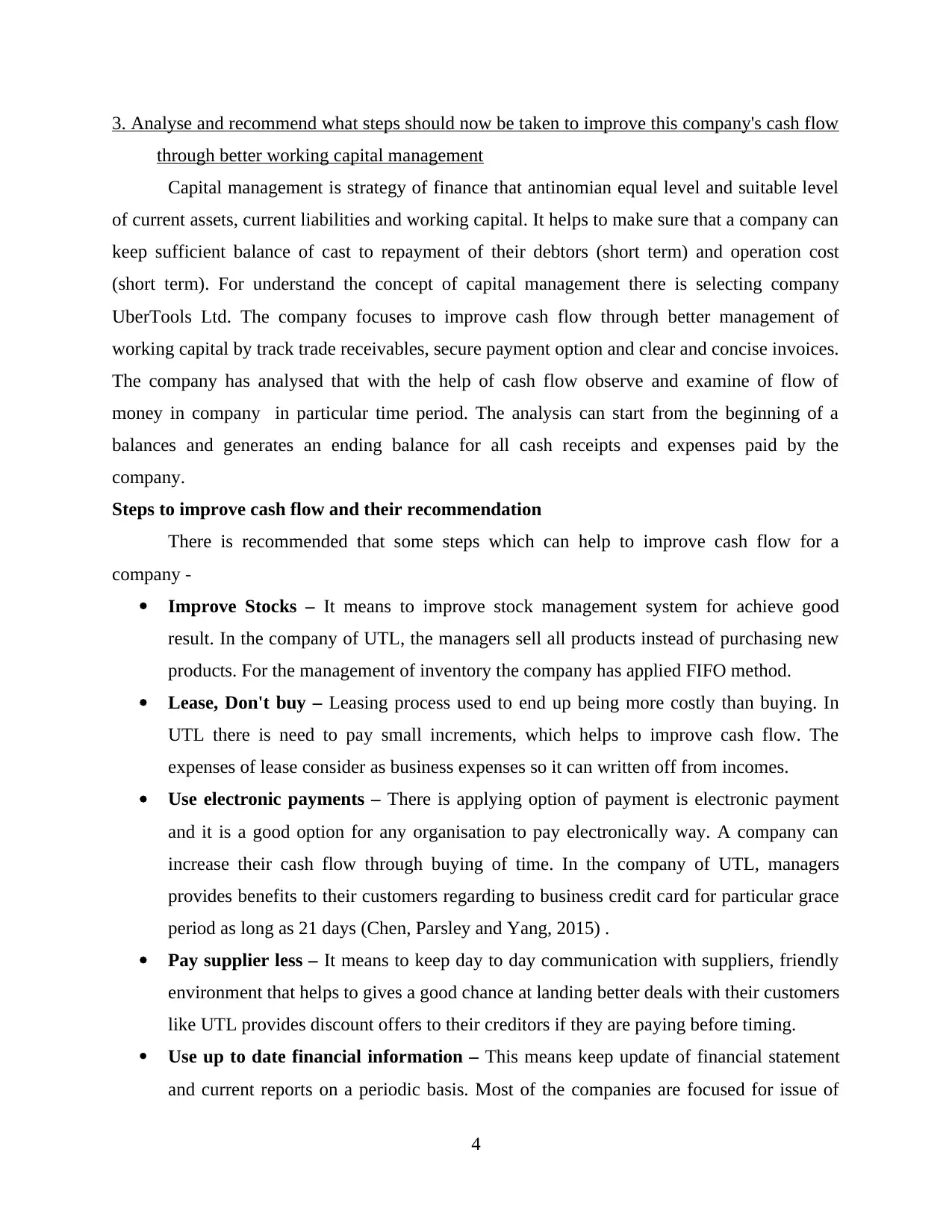
3. Analyse and recommend what steps should now be taken to improve this company's cash flow
through better working capital management
Capital management is strategy of finance that antinomian equal level and suitable level
of current assets, current liabilities and working capital. It helps to make sure that a company can
keep sufficient balance of cast to repayment of their debtors (short term) and operation cost
(short term). For understand the concept of capital management there is selecting company
UberTools Ltd. The company focuses to improve cash flow through better management of
working capital by track trade receivables, secure payment option and clear and concise invoices.
The company has analysed that with the help of cash flow observe and examine of flow of
money in company in particular time period. The analysis can start from the beginning of a
balances and generates an ending balance for all cash receipts and expenses paid by the
company.
Steps to improve cash flow and their recommendation
There is recommended that some steps which can help to improve cash flow for a
company -
Improve Stocks – It means to improve stock management system for achieve good
result. In the company of UTL, the managers sell all products instead of purchasing new
products. For the management of inventory the company has applied FIFO method.
Lease, Don't buy – Leasing process used to end up being more costly than buying. In
UTL there is need to pay small increments, which helps to improve cash flow. The
expenses of lease consider as business expenses so it can written off from incomes.
Use electronic payments – There is applying option of payment is electronic payment
and it is a good option for any organisation to pay electronically way. A company can
increase their cash flow through buying of time. In the company of UTL, managers
provides benefits to their customers regarding to business credit card for particular grace
period as long as 21 days (Chen, Parsley and Yang, 2015) .
Pay supplier less – It means to keep day to day communication with suppliers, friendly
environment that helps to gives a good chance at landing better deals with their customers
like UTL provides discount offers to their creditors if they are paying before timing.
Use up to date financial information – This means keep update of financial statement
and current reports on a periodic basis. Most of the companies are focused for issue of
4
through better working capital management
Capital management is strategy of finance that antinomian equal level and suitable level
of current assets, current liabilities and working capital. It helps to make sure that a company can
keep sufficient balance of cast to repayment of their debtors (short term) and operation cost
(short term). For understand the concept of capital management there is selecting company
UberTools Ltd. The company focuses to improve cash flow through better management of
working capital by track trade receivables, secure payment option and clear and concise invoices.
The company has analysed that with the help of cash flow observe and examine of flow of
money in company in particular time period. The analysis can start from the beginning of a
balances and generates an ending balance for all cash receipts and expenses paid by the
company.
Steps to improve cash flow and their recommendation
There is recommended that some steps which can help to improve cash flow for a
company -
Improve Stocks – It means to improve stock management system for achieve good
result. In the company of UTL, the managers sell all products instead of purchasing new
products. For the management of inventory the company has applied FIFO method.
Lease, Don't buy – Leasing process used to end up being more costly than buying. In
UTL there is need to pay small increments, which helps to improve cash flow. The
expenses of lease consider as business expenses so it can written off from incomes.
Use electronic payments – There is applying option of payment is electronic payment
and it is a good option for any organisation to pay electronically way. A company can
increase their cash flow through buying of time. In the company of UTL, managers
provides benefits to their customers regarding to business credit card for particular grace
period as long as 21 days (Chen, Parsley and Yang, 2015) .
Pay supplier less – It means to keep day to day communication with suppliers, friendly
environment that helps to gives a good chance at landing better deals with their customers
like UTL provides discount offers to their creditors if they are paying before timing.
Use up to date financial information – This means keep update of financial statement
and current reports on a periodic basis. Most of the companies are focused for issue of
4
⊘ This is a preview!⊘
Do you want full access?
Subscribe today to unlock all pages.

Trusted by 1+ million students worldwide
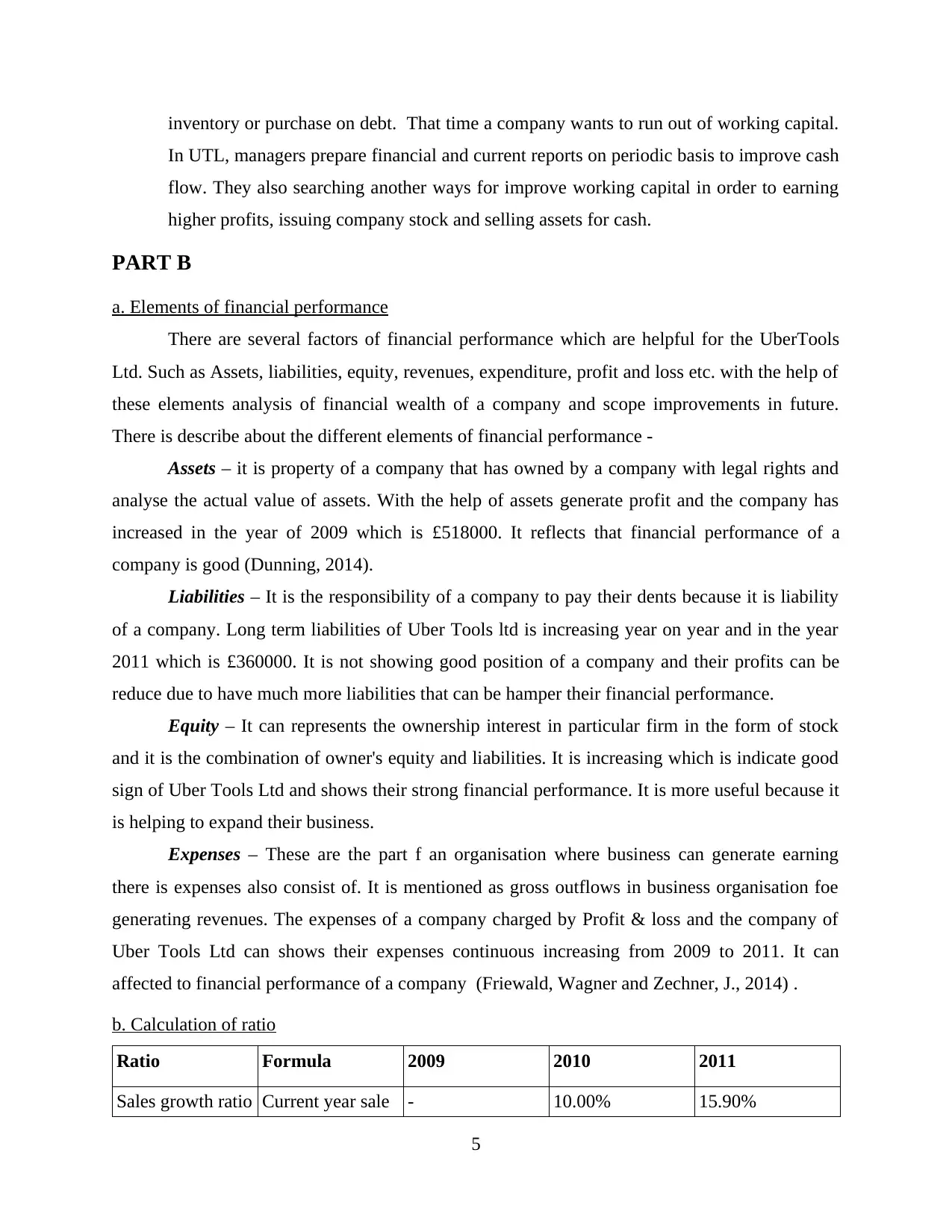
inventory or purchase on debt. That time a company wants to run out of working capital.
In UTL, managers prepare financial and current reports on periodic basis to improve cash
flow. They also searching another ways for improve working capital in order to earning
higher profits, issuing company stock and selling assets for cash.
PART B
a. Elements of financial performance
There are several factors of financial performance which are helpful for the UberTools
Ltd. Such as Assets, liabilities, equity, revenues, expenditure, profit and loss etc. with the help of
these elements analysis of financial wealth of a company and scope improvements in future.
There is describe about the different elements of financial performance -
Assets – it is property of a company that has owned by a company with legal rights and
analyse the actual value of assets. With the help of assets generate profit and the company has
increased in the year of 2009 which is £518000. It reflects that financial performance of a
company is good (Dunning, 2014).
Liabilities – It is the responsibility of a company to pay their dents because it is liability
of a company. Long term liabilities of Uber Tools ltd is increasing year on year and in the year
2011 which is £360000. It is not showing good position of a company and their profits can be
reduce due to have much more liabilities that can be hamper their financial performance.
Equity – It can represents the ownership interest in particular firm in the form of stock
and it is the combination of owner's equity and liabilities. It is increasing which is indicate good
sign of Uber Tools Ltd and shows their strong financial performance. It is more useful because it
is helping to expand their business.
Expenses – These are the part f an organisation where business can generate earning
there is expenses also consist of. It is mentioned as gross outflows in business organisation foe
generating revenues. The expenses of a company charged by Profit & loss and the company of
Uber Tools Ltd can shows their expenses continuous increasing from 2009 to 2011. It can
affected to financial performance of a company (Friewald, Wagner and Zechner, J., 2014) .
b. Calculation of ratio
Ratio Formula 2009 2010 2011
Sales growth ratio Current year sale - 10.00% 15.90%
5
In UTL, managers prepare financial and current reports on periodic basis to improve cash
flow. They also searching another ways for improve working capital in order to earning
higher profits, issuing company stock and selling assets for cash.
PART B
a. Elements of financial performance
There are several factors of financial performance which are helpful for the UberTools
Ltd. Such as Assets, liabilities, equity, revenues, expenditure, profit and loss etc. with the help of
these elements analysis of financial wealth of a company and scope improvements in future.
There is describe about the different elements of financial performance -
Assets – it is property of a company that has owned by a company with legal rights and
analyse the actual value of assets. With the help of assets generate profit and the company has
increased in the year of 2009 which is £518000. It reflects that financial performance of a
company is good (Dunning, 2014).
Liabilities – It is the responsibility of a company to pay their dents because it is liability
of a company. Long term liabilities of Uber Tools ltd is increasing year on year and in the year
2011 which is £360000. It is not showing good position of a company and their profits can be
reduce due to have much more liabilities that can be hamper their financial performance.
Equity – It can represents the ownership interest in particular firm in the form of stock
and it is the combination of owner's equity and liabilities. It is increasing which is indicate good
sign of Uber Tools Ltd and shows their strong financial performance. It is more useful because it
is helping to expand their business.
Expenses – These are the part f an organisation where business can generate earning
there is expenses also consist of. It is mentioned as gross outflows in business organisation foe
generating revenues. The expenses of a company charged by Profit & loss and the company of
Uber Tools Ltd can shows their expenses continuous increasing from 2009 to 2011. It can
affected to financial performance of a company (Friewald, Wagner and Zechner, J., 2014) .
b. Calculation of ratio
Ratio Formula 2009 2010 2011
Sales growth ratio Current year sale - 10.00% 15.90%
5
Paraphrase This Document
Need a fresh take? Get an instant paraphrase of this document with our AI Paraphraser
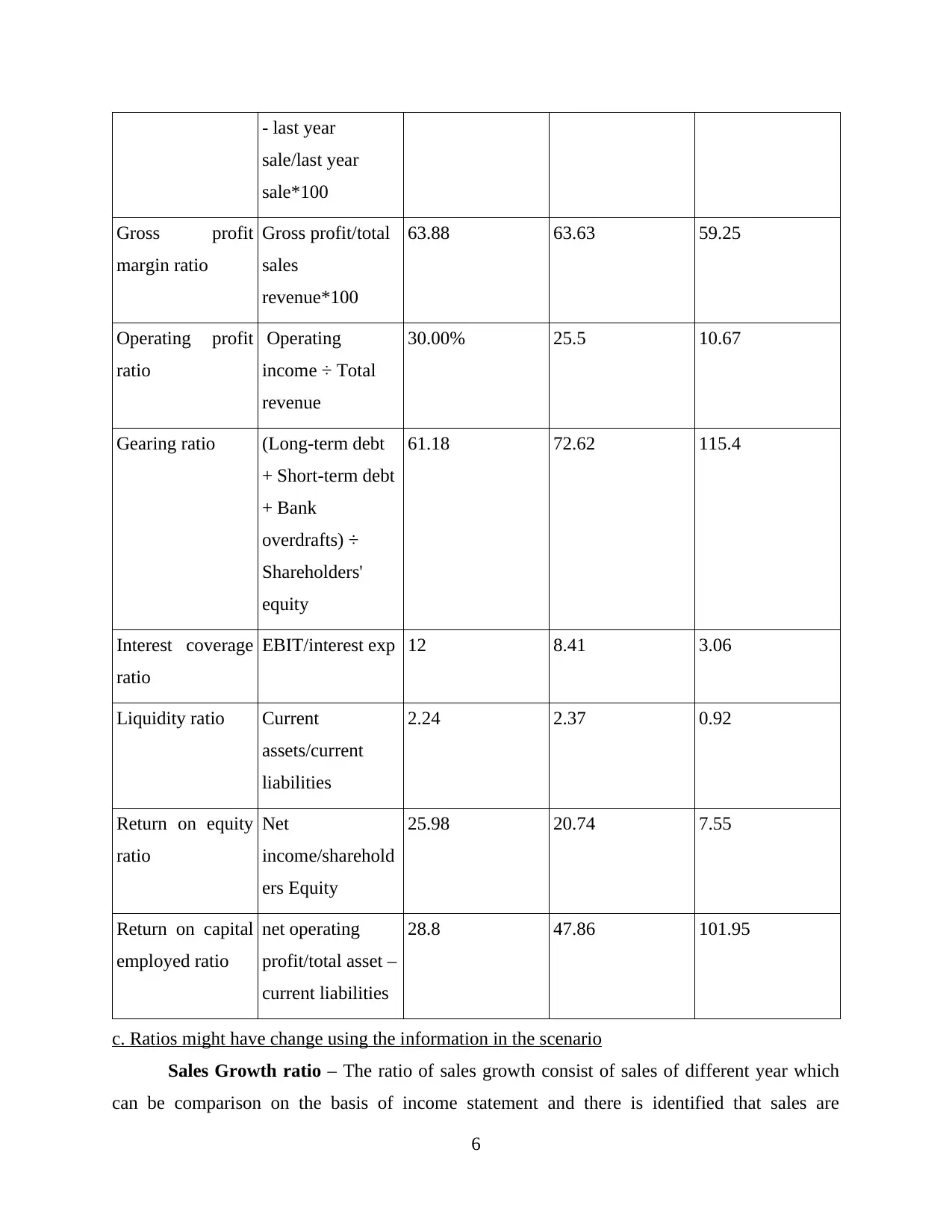
- last year
sale/last year
sale*100
Gross profit
margin ratio
Gross profit/total
sales
revenue*100
63.88 63.63 59.25
Operating profit
ratio
Operating
income ÷ Total
revenue
30.00% 25.5 10.67
Gearing ratio (Long-term debt
+ Short-term debt
+ Bank
overdrafts) ÷
Shareholders'
equity
61.18 72.62 115.4
Interest coverage
ratio
EBIT/interest exp 12 8.41 3.06
Liquidity ratio Current
assets/current
liabilities
2.24 2.37 0.92
Return on equity
ratio
Net
income/sharehold
ers Equity
25.98 20.74 7.55
Return on capital
employed ratio
net operating
profit/total asset –
current liabilities
28.8 47.86 101.95
c. Ratios might have change using the information in the scenario
Sales Growth ratio – The ratio of sales growth consist of sales of different year which
can be comparison on the basis of income statement and there is identified that sales are
6
sale/last year
sale*100
Gross profit
margin ratio
Gross profit/total
sales
revenue*100
63.88 63.63 59.25
Operating profit
ratio
Operating
income ÷ Total
revenue
30.00% 25.5 10.67
Gearing ratio (Long-term debt
+ Short-term debt
+ Bank
overdrafts) ÷
Shareholders'
equity
61.18 72.62 115.4
Interest coverage
ratio
EBIT/interest exp 12 8.41 3.06
Liquidity ratio Current
assets/current
liabilities
2.24 2.37 0.92
Return on equity
ratio
Net
income/sharehold
ers Equity
25.98 20.74 7.55
Return on capital
employed ratio
net operating
profit/total asset –
current liabilities
28.8 47.86 101.95
c. Ratios might have change using the information in the scenario
Sales Growth ratio – The ratio of sales growth consist of sales of different year which
can be comparison on the basis of income statement and there is identified that sales are
6
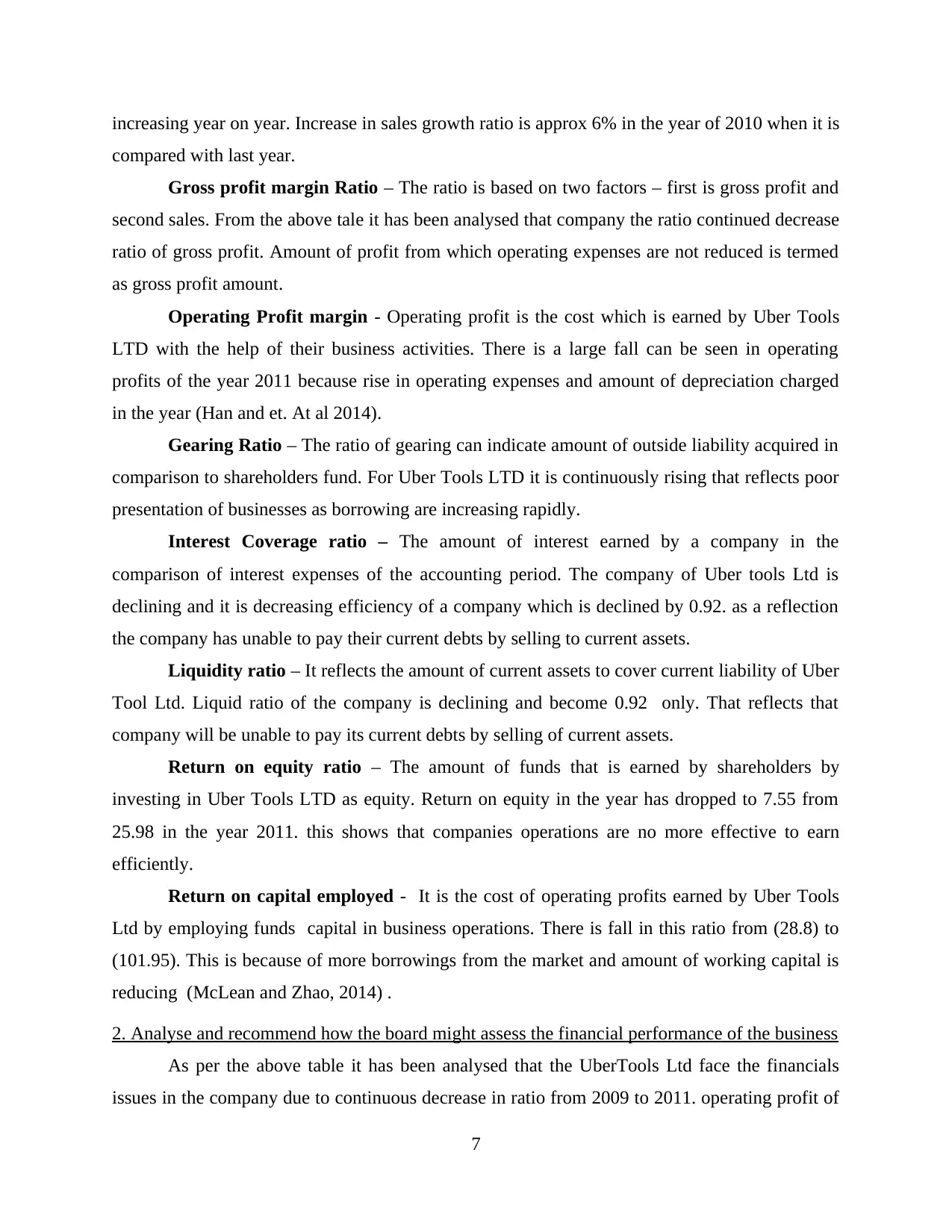
increasing year on year. Increase in sales growth ratio is approx 6% in the year of 2010 when it is
compared with last year.
Gross profit margin Ratio – The ratio is based on two factors – first is gross profit and
second sales. From the above tale it has been analysed that company the ratio continued decrease
ratio of gross profit. Amount of profit from which operating expenses are not reduced is termed
as gross profit amount.
Operating Profit margin - Operating profit is the cost which is earned by Uber Tools
LTD with the help of their business activities. There is a large fall can be seen in operating
profits of the year 2011 because rise in operating expenses and amount of depreciation charged
in the year (Han and et. At al 2014).
Gearing Ratio – The ratio of gearing can indicate amount of outside liability acquired in
comparison to shareholders fund. For Uber Tools LTD it is continuously rising that reflects poor
presentation of businesses as borrowing are increasing rapidly.
Interest Coverage ratio – The amount of interest earned by a company in the
comparison of interest expenses of the accounting period. The company of Uber tools Ltd is
declining and it is decreasing efficiency of a company which is declined by 0.92. as a reflection
the company has unable to pay their current debts by selling to current assets.
Liquidity ratio – It reflects the amount of current assets to cover current liability of Uber
Tool Ltd. Liquid ratio of the company is declining and become 0.92 only. That reflects that
company will be unable to pay its current debts by selling of current assets.
Return on equity ratio – The amount of funds that is earned by shareholders by
investing in Uber Tools LTD as equity. Return on equity in the year has dropped to 7.55 from
25.98 in the year 2011. this shows that companies operations are no more effective to earn
efficiently.
Return on capital employed - It is the cost of operating profits earned by Uber Tools
Ltd by employing funds capital in business operations. There is fall in this ratio from (28.8) to
(101.95). This is because of more borrowings from the market and amount of working capital is
reducing (McLean and Zhao, 2014) .
2. Analyse and recommend how the board might assess the financial performance of the business
As per the above table it has been analysed that the UberTools Ltd face the financials
issues in the company due to continuous decrease in ratio from 2009 to 2011. operating profit of
7
compared with last year.
Gross profit margin Ratio – The ratio is based on two factors – first is gross profit and
second sales. From the above tale it has been analysed that company the ratio continued decrease
ratio of gross profit. Amount of profit from which operating expenses are not reduced is termed
as gross profit amount.
Operating Profit margin - Operating profit is the cost which is earned by Uber Tools
LTD with the help of their business activities. There is a large fall can be seen in operating
profits of the year 2011 because rise in operating expenses and amount of depreciation charged
in the year (Han and et. At al 2014).
Gearing Ratio – The ratio of gearing can indicate amount of outside liability acquired in
comparison to shareholders fund. For Uber Tools LTD it is continuously rising that reflects poor
presentation of businesses as borrowing are increasing rapidly.
Interest Coverage ratio – The amount of interest earned by a company in the
comparison of interest expenses of the accounting period. The company of Uber tools Ltd is
declining and it is decreasing efficiency of a company which is declined by 0.92. as a reflection
the company has unable to pay their current debts by selling to current assets.
Liquidity ratio – It reflects the amount of current assets to cover current liability of Uber
Tool Ltd. Liquid ratio of the company is declining and become 0.92 only. That reflects that
company will be unable to pay its current debts by selling of current assets.
Return on equity ratio – The amount of funds that is earned by shareholders by
investing in Uber Tools LTD as equity. Return on equity in the year has dropped to 7.55 from
25.98 in the year 2011. this shows that companies operations are no more effective to earn
efficiently.
Return on capital employed - It is the cost of operating profits earned by Uber Tools
Ltd by employing funds capital in business operations. There is fall in this ratio from (28.8) to
(101.95). This is because of more borrowings from the market and amount of working capital is
reducing (McLean and Zhao, 2014) .
2. Analyse and recommend how the board might assess the financial performance of the business
As per the above table it has been analysed that the UberTools Ltd face the financials
issues in the company due to continuous decrease in ratio from 2009 to 2011. operating profit of
7
⊘ This is a preview!⊘
Do you want full access?
Subscribe today to unlock all pages.

Trusted by 1+ million students worldwide
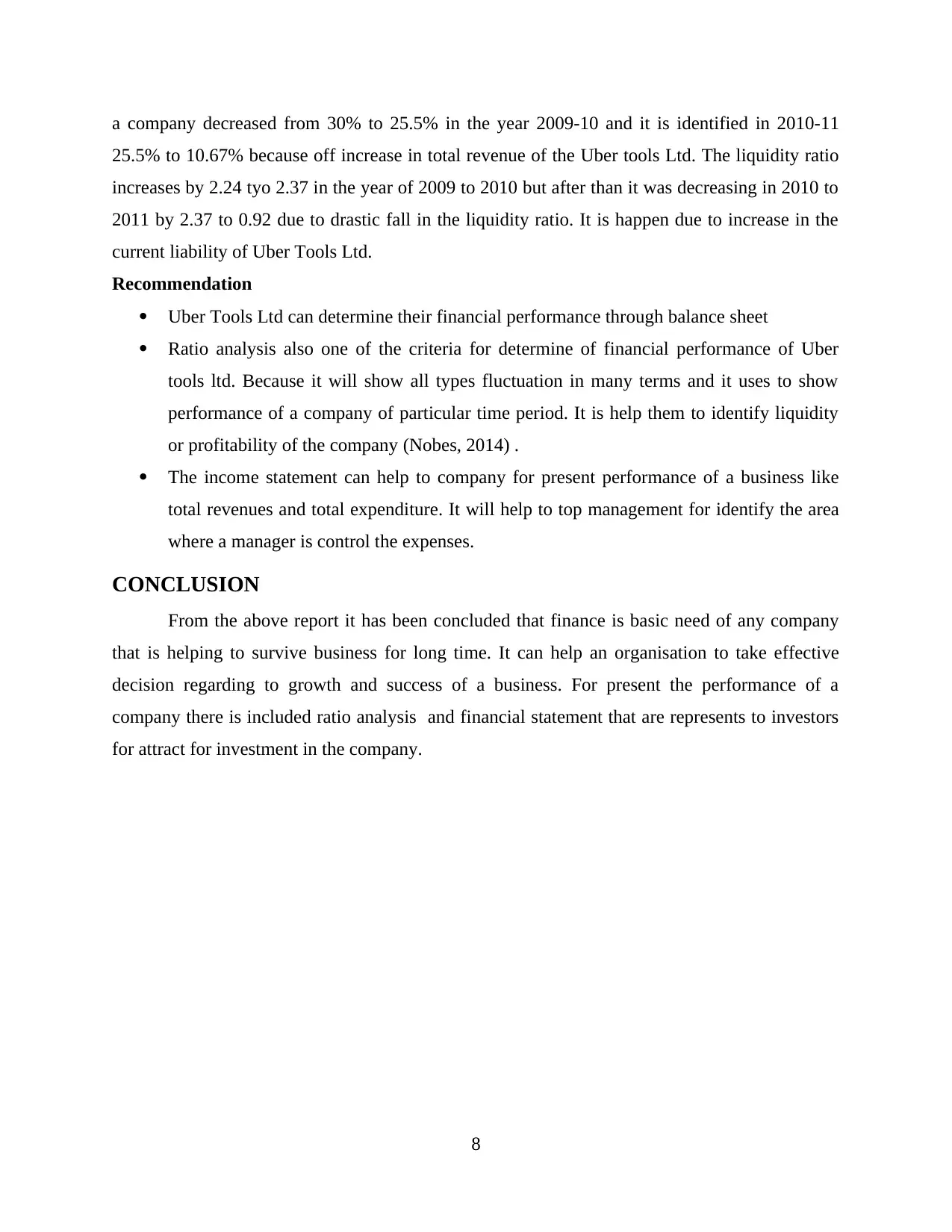
a company decreased from 30% to 25.5% in the year 2009-10 and it is identified in 2010-11
25.5% to 10.67% because off increase in total revenue of the Uber tools Ltd. The liquidity ratio
increases by 2.24 tyo 2.37 in the year of 2009 to 2010 but after than it was decreasing in 2010 to
2011 by 2.37 to 0.92 due to drastic fall in the liquidity ratio. It is happen due to increase in the
current liability of Uber Tools Ltd.
Recommendation
Uber Tools Ltd can determine their financial performance through balance sheet
Ratio analysis also one of the criteria for determine of financial performance of Uber
tools ltd. Because it will show all types fluctuation in many terms and it uses to show
performance of a company of particular time period. It is help them to identify liquidity
or profitability of the company (Nobes, 2014) .
The income statement can help to company for present performance of a business like
total revenues and total expenditure. It will help to top management for identify the area
where a manager is control the expenses.
CONCLUSION
From the above report it has been concluded that finance is basic need of any company
that is helping to survive business for long time. It can help an organisation to take effective
decision regarding to growth and success of a business. For present the performance of a
company there is included ratio analysis and financial statement that are represents to investors
for attract for investment in the company.
8
25.5% to 10.67% because off increase in total revenue of the Uber tools Ltd. The liquidity ratio
increases by 2.24 tyo 2.37 in the year of 2009 to 2010 but after than it was decreasing in 2010 to
2011 by 2.37 to 0.92 due to drastic fall in the liquidity ratio. It is happen due to increase in the
current liability of Uber Tools Ltd.
Recommendation
Uber Tools Ltd can determine their financial performance through balance sheet
Ratio analysis also one of the criteria for determine of financial performance of Uber
tools ltd. Because it will show all types fluctuation in many terms and it uses to show
performance of a company of particular time period. It is help them to identify liquidity
or profitability of the company (Nobes, 2014) .
The income statement can help to company for present performance of a business like
total revenues and total expenditure. It will help to top management for identify the area
where a manager is control the expenses.
CONCLUSION
From the above report it has been concluded that finance is basic need of any company
that is helping to survive business for long time. It can help an organisation to take effective
decision regarding to growth and success of a business. For present the performance of a
company there is included ratio analysis and financial statement that are represents to investors
for attract for investment in the company.
8
Paraphrase This Document
Need a fresh take? Get an instant paraphrase of this document with our AI Paraphraser
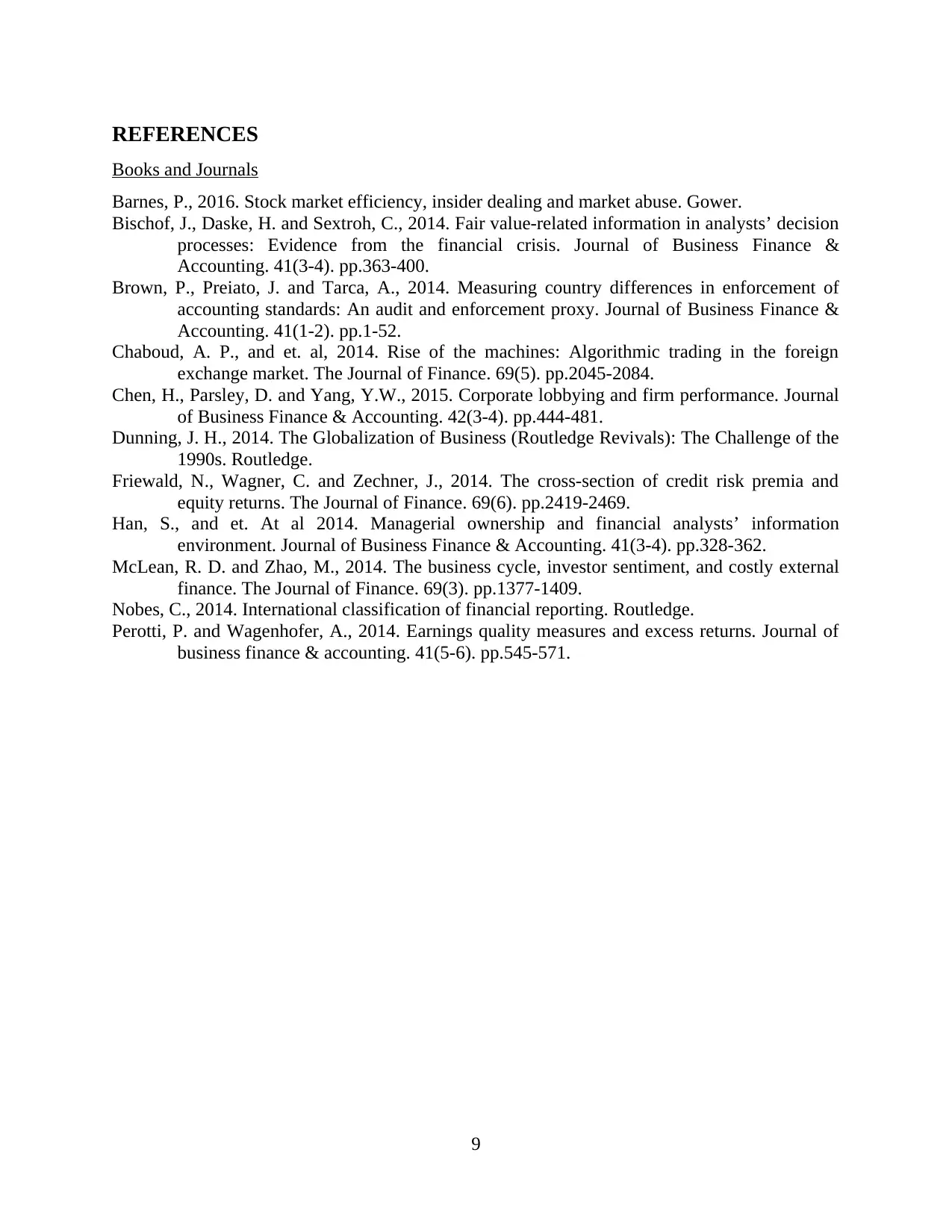
REFERENCES
Books and Journals
Barnes, P., 2016. Stock market efficiency, insider dealing and market abuse. Gower.
Bischof, J., Daske, H. and Sextroh, C., 2014. Fair value‐related information in analysts’ decision
processes: Evidence from the financial crisis. Journal of Business Finance &
Accounting. 41(3-4). pp.363-400.
Brown, P., Preiato, J. and Tarca, A., 2014. Measuring country differences in enforcement of
accounting standards: An audit and enforcement proxy. Journal of Business Finance &
Accounting. 41(1-2). pp.1-52.
Chaboud, A. P., and et. al, 2014. Rise of the machines: Algorithmic trading in the foreign
exchange market. The Journal of Finance. 69(5). pp.2045-2084.
Chen, H., Parsley, D. and Yang, Y.W., 2015. Corporate lobbying and firm performance. Journal
of Business Finance & Accounting. 42(3-4). pp.444-481.
Dunning, J. H., 2014. The Globalization of Business (Routledge Revivals): The Challenge of the
1990s. Routledge.
Friewald, N., Wagner, C. and Zechner, J., 2014. The cross‐section of credit risk premia and
equity returns. The Journal of Finance. 69(6). pp.2419-2469.
Han, S., and et. At al 2014. Managerial ownership and financial analysts’ information
environment. Journal of Business Finance & Accounting. 41(3-4). pp.328-362.
McLean, R. D. and Zhao, M., 2014. The business cycle, investor sentiment, and costly external
finance. The Journal of Finance. 69(3). pp.1377-1409.
Nobes, C., 2014. International classification of financial reporting. Routledge.
Perotti, P. and Wagenhofer, A., 2014. Earnings quality measures and excess returns. Journal of
business finance & accounting. 41(5-6). pp.545-571.
9
Books and Journals
Barnes, P., 2016. Stock market efficiency, insider dealing and market abuse. Gower.
Bischof, J., Daske, H. and Sextroh, C., 2014. Fair value‐related information in analysts’ decision
processes: Evidence from the financial crisis. Journal of Business Finance &
Accounting. 41(3-4). pp.363-400.
Brown, P., Preiato, J. and Tarca, A., 2014. Measuring country differences in enforcement of
accounting standards: An audit and enforcement proxy. Journal of Business Finance &
Accounting. 41(1-2). pp.1-52.
Chaboud, A. P., and et. al, 2014. Rise of the machines: Algorithmic trading in the foreign
exchange market. The Journal of Finance. 69(5). pp.2045-2084.
Chen, H., Parsley, D. and Yang, Y.W., 2015. Corporate lobbying and firm performance. Journal
of Business Finance & Accounting. 42(3-4). pp.444-481.
Dunning, J. H., 2014. The Globalization of Business (Routledge Revivals): The Challenge of the
1990s. Routledge.
Friewald, N., Wagner, C. and Zechner, J., 2014. The cross‐section of credit risk premia and
equity returns. The Journal of Finance. 69(6). pp.2419-2469.
Han, S., and et. At al 2014. Managerial ownership and financial analysts’ information
environment. Journal of Business Finance & Accounting. 41(3-4). pp.328-362.
McLean, R. D. and Zhao, M., 2014. The business cycle, investor sentiment, and costly external
finance. The Journal of Finance. 69(3). pp.1377-1409.
Nobes, C., 2014. International classification of financial reporting. Routledge.
Perotti, P. and Wagenhofer, A., 2014. Earnings quality measures and excess returns. Journal of
business finance & accounting. 41(5-6). pp.545-571.
9
1 out of 11
Related Documents
Your All-in-One AI-Powered Toolkit for Academic Success.
+13062052269
info@desklib.com
Available 24*7 on WhatsApp / Email
![[object Object]](/_next/static/media/star-bottom.7253800d.svg)
Unlock your academic potential
Copyright © 2020–2025 A2Z Services. All Rights Reserved. Developed and managed by ZUCOL.





